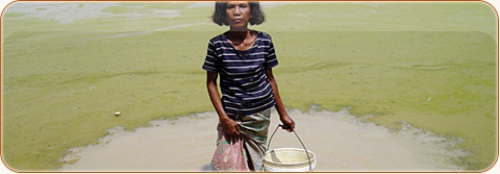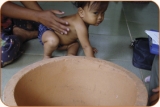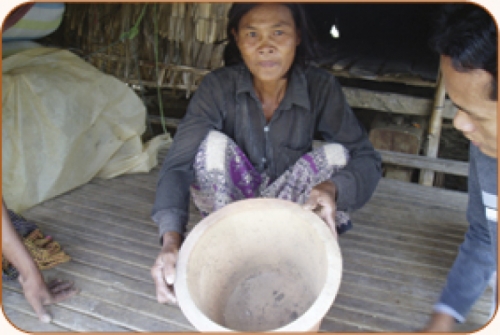We see them every day, those commercials for charities in the developing world, where a child kneels by a muddy stream to drink. Most of us have never had to depend on untreated sources of water, to be surrounded by water that’s too dirty to drink, to have to drink it anyway. And most of us have no idea what it means to watch a child grow dehydrated and weak from diarrhea and not know what’s causing it.
But in Cambodia, waterborne illnesses are a major public health problem, particularly for the rural poor. Joe Brown describes a world of waving mango trees and flat, swampy expanses. Water abounds in rivers, rain collection systems, lakes, wells, and the stagnant pools left by floods. But the untreated water teems with pathogens—bacteria, parasites, and viruses—deposited by human and animal waste. Cambodia has only two piped water supply systems—one in each of the two largest cities—and neither is properly treated. That, Brown says, is not likely to change any time soon. Building treated, piped water systems requires money, infrastructure, and expertise that don’t exist in Cambodia, where diarrheal illnesses are a major killer. Most of the victims are less than five years old. Researchers estimate that anywhere from 15 to 80 percent of Cambodia’s diarrheal disease comes from drinking water.
“Something we think of as annoying is one of the major health problems in Cambodia,” Brown says. “They have very few choices when it comes to water.”
But sometimes the answer is right under your shoes.
Brown is trying to help Cambodian people clean their water with the same dirt that they’ve been walking on all of their lives. He’s working with not-for-profit groups to develop a ceramic water filter, locally made from clay, for home use.
Brown has come up with a recipe for a filter that kills over 99 percent of the viruses that cause life-threatening diarrhea and other illnesses. The filter’s key ingredient is goethite, an iron oxyhydroxide commonly found in the tropical soils of many of the world’s poorest countries. Brown developed the idea with his advisor Mark Sobsey, then collaborated on the design with Potters for Peace, a not-for-profit group based in Nicaragua.
Brown’s idea builds on existing but less effective water filters already in use around the world. A ceramic filter element resembling a flower pot sits inside a receiving container. When water is poured into the top of the container, it trickles through the porous ceramic filter into the bottom of the container, where it is released through a tap.
But existing clay filters don’t remove viruses, which are much too small to get trapped in the pores of the clay. So Brown added goethite.
When we think of Johann Wolfgang von Goethe, we usually think of Faust. But Goethe was also interested in mineralogy and mining. Goethe’s mineralogical namesake, goethite, has been used as a yellow pigment for centuries. It’s in house paint, and it’s in the ancient handprints and animal images on the walls of the Caves of Lascaux. And it happens to be one of the most common elements in tropical soils.
Brown knew that various kinds of metal oxyhydroxides could create a fatal attraction for viruses on a water filter’s surface. Most treatable water has a neutral pH, and viruses in neutral pH water tend to have a slightly negative charge. Goethite, on the other hand, effectively creates a positive charge when it is mixed into ordinary ceramic clay in the right proportions. This positive charge on the filter’s surface inactivates the viruses. The clay’s pores catch larger organisms such as bacteria and protozoan parasites, and the water comes out of the tap much cleaner and safer to drink.
Adding goethite to the filters already manufactured in Cambodia adds only 25 cents to the price, Brown says. The simpler clay filter, with no virus-killing properties, costs $7. But the average yearly wage in Cambodia is only about $350.
“It really represents a substantial investment,” Brown says. “It’s basically a week’s income.” This drives him to make sure that the filter is as effective as possible. He’s working as a consultant for UNICEF, conducting field trials with eight colleagues in Cambodia to test the filter’s ability to inactivate viruses and to maintain that ability through repeated use. And he drinks the filtered water himself.
“I use the ceramic filters we promote, partly because I believe in the technology and partly because I’m a scientist,” he says. “What better research subject than yourself?”
Joe Brown is a doctoral student in the Department of Environmental Sciences and Engineering at Carolina.






